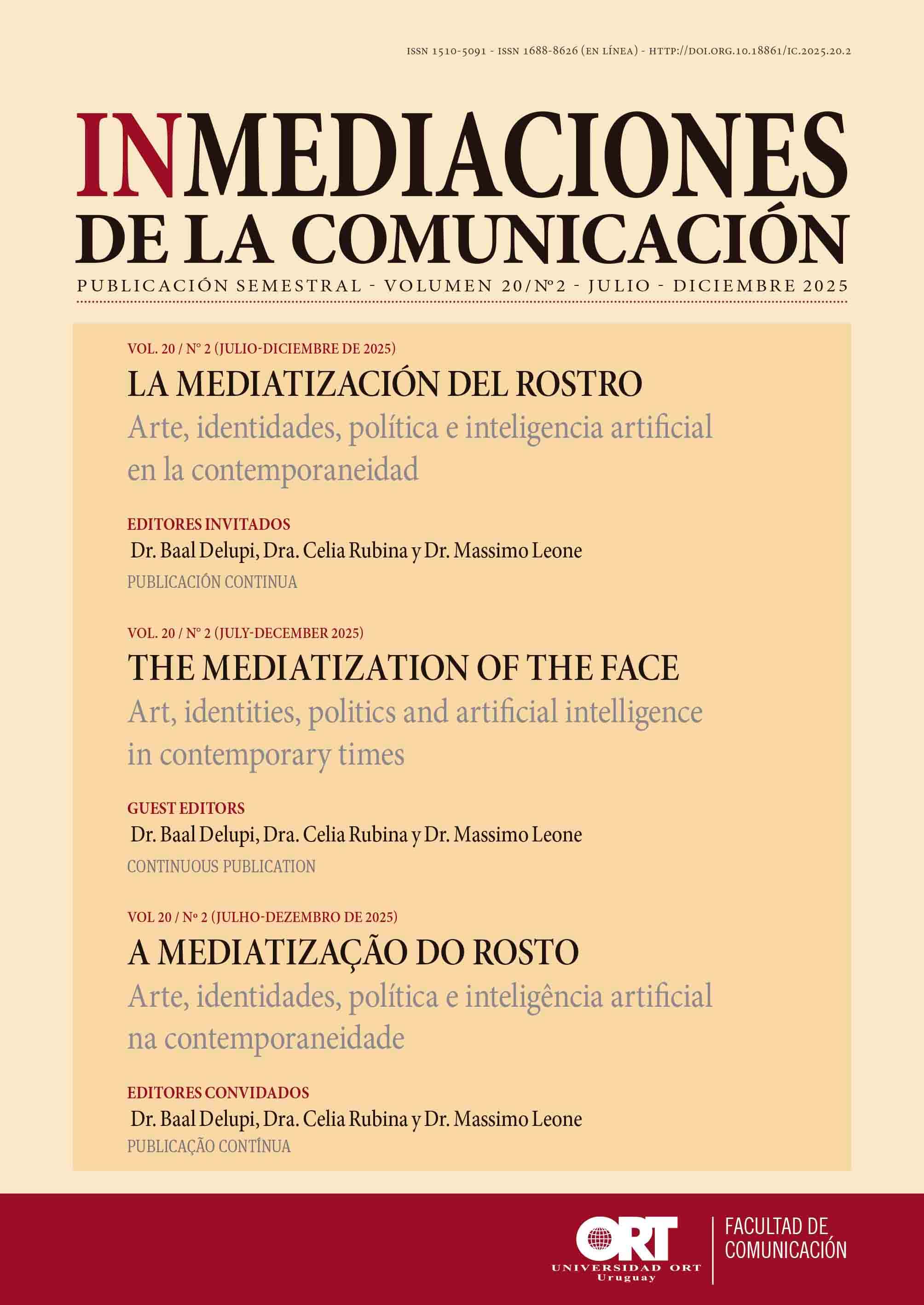President Volodymir Zelensky's gestures
An analytical approach
DOI:
https://doi.org/10.18861/ic.2025.20.2.4106Keywords:
communication, discourse, gestures, kinesics, ZelenskiAbstract
The article presents a case study on the non-verbal aspects of discourse, focusing on the kinesic and proxemic elements of Ukrainian President Volodymyr Zelensky´s speeches. It is based on the understanding that acts of communication —in this case, of a political nature— are complex processes involving linguistic, paralinguistic and nonverbal elements that inform and communicate, regulating discourse within a given situation and context. In an image centred society, gestures, posture, setting, clothing and environment are decisive factors in achieving objetives and generating support for a cause. In this regard, the following categories are analysed: proxemic, body language, eye contac and facial-gestuarl expression, following the basic categorization of Ussa (2013), the classification of gestures proposed by Calvo, García and Pérez (2013) and the satudy on the rostrosfera (face sphere) proposed by Finol and Finol (2021). The results show that the Ukrainian president´s gestural expression varies depending on the context and his interlocutors. As a contrasting example, his remote interventions with European parliamentarians at the beginning of the conflict between his country and Russia are characterized by more restrained gestures, while those made at the White House alongside US President Donald Trump reveal greater expressiveness, illustrating how contexts, audiences and interlocutors influence gestural communication.
Downloads
References
Bauer, N. M. & Carpinella, C. (2017). Visual information and candidate evaluations: The influence of feminine and masculine images on support for female candidates. Political Research Quarterly, 71, 395-407. https://www.doi.org/10.1177/1065912917738579
Calvo, A.; García, I. & Pérez, R. (2013). Expresión corporal. Una práctica de intervención que permite encontrar un lenguaje propio mediante el estudio y la profundización del empleo del cuerpo. Retos: nuevas tendencias en educación física, deporte y recreación, 23, 19-22. http://dialnet.unirioja.es/servlet/articulo?codigo=4135190
Capriotti, P. (1999). Comunicación corporativa: Una estrategia de éxito a corto plazo. Reporte C&D – Capacitación y Desarrollo, 13, 30-33.
Cestero Mancera, A. M. (2018). Recursos no verbales en comunicación persuasiva: gestos. ZER, 23(44), 69-92, https://doi.org/10.1387/zer.18130
Coseriu, E. (1990). Teoría del lenguaje y lingüística general. Gredos
De Santiago, J. (2005). Principios de comunicación persuasiva. Arco Libros.
Dobbs, L. (2022). Es Churchill en camiseta. Zelenski abronca a los líderes mundiales desde su búnker de guerra. El periódico de España. https://www.epe.es/es/internacional/20220318/camiseta-discurso-zelenski-13394373
Fernández-Hoya, G. & Cáceres Zapatero, M. D. (2022). La comunicación no verbal de Santiago Abascal, presidente de VOX. Communication & Society, 35(3), 51-71. https://doi.org/10.15581/003.35.3.51-71
Finol, J. E. & Finol, D. E. (2021). La rostrosfera: mediatización entre lo analógico, lo real y lo digital. deSignis, HORS SERIE o1, 11-23. https://www.designisfels.net/wp-content/uploads/2021/10/HORS-SERIE-01.pdf
Fornés, A. & Rodríguez-Escalona, M. (2008). El porqué de nuestros gestos. Bolsillo Octaedro.
Gayol, S. (2024). La cara de Perón: emociones y polarización política en Argentina. Mélanges de la Casa de Velazquez. Nouvelle serie, 54(1), 351-358. https://ri.conicet.gov.ar/bitstream/handle/11336/241652/CONICET_Digital_Nro.e29bd361-6906-40f0-9170-f37e7cdf5d54_B.pdf?sequence=2&isAllowed=y
Goleman, D. (1995). La Inteligencia emocional. Panamericana Formas e Impresos.
Gong, Z. H. & Bucy, E. K. (2016). When style obscures substance: Visual attention to display appropriateness in the 2012 presidential debates. Communication Monographs, 83, 349-372. https://www.doi.org/10.1080/03637751.2015.1119868
González Martín, A. (2022). ¿Es Volodímir Zelenski el héroe necesario o no? Centro de Estudios Estratégicos del Ejército del Perú. https://goo.su/uUVLNvq
Guaïtella, I. & Santi, S. (1998). Les relations voco-gestuelles dans la communication interpersonnelle. Dans Santi, I., Guaïtella, I. & Konopczynsky, G. P. (éditeurs), Oralité et gestualité communication multimodale, interaction (pp. 13-24). L´Harmattan.
Halliday, M. A. K. (1978). Language as social semiotic: The social interpretation of language and meaning. Edward Arnold.
Hymes, D. (1971). Competence and performance in linguistic theory. En Huxley, R. & Ingram, E. (eds.), Acquisition of languages: Models and methods (pp. 3-23). Academic Press.
López Viera, L. (2015) La influencia del lenguaje no verbal en la mediación. Revista de Mediación, 8(2). https://accedacris.ulpgc.es/bitstream/10553/15892/5/Revista16_e6.pdf
Lyons, J. (1981). Lenguaje, significado y contexto. Paidós Comunicación.
Marrone, G. (2019). Fragmentos de un discurso político. Intervençôes críticas. Revistas de estudios semióticos, 15(1) 1-17.
Mehrabian, A. (1972). Nonverbal Communication. Walter de Gruyter.
Pease, A. (1987). El lenguaje del cuerpo. Planeta Colombiana Editorial.
Pease, A. (2010). Comunicación no verbal. El lenguaje del cuerpo. Amat.
Peña-Jiménez, P. (2025) Discurso político en la era digital. Los discursos en los parlamentos extranjeros del presidente de Ucrania, Volodimir Zelenski. Círculo de Lingüística aplicada a la Comunicación, 104 (2025): 101-110. https://dx.doi.org/10.5209/clac.96572
Poyatos, F. (1994). La comunicación no verbal. Cultura, lenguaje y conversación. Istmo.
Ussa Álvarez, M. C. (2013). Semántica gestual y comunicación humana. Cuadernos de Lingüística Hispánica, 21, 89-102.
van Dijk, T. (2005). Estructuras y Funciones del Discurso. Siglo XXI.
van Dijk, T. (2008). Discourse and context: a socio-cognitive approach. Cambridge University Press.
van Dijk, T. (2016). Análisis crítico del discurso. Revista Austral de Ciencias Sociales 30, 203-222. http://revistas.uach.cl/pdf/racs/n30/art10.pdf
Wodak, R. & Meyer, M. (2003). Métodos de análisis crítico del discurso. Gedisa.
Wodak, R. (2015). The Politics of Fear. What Right Wing Populist Discourses Mean. SAGE.






